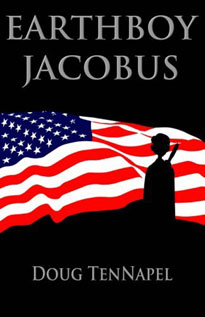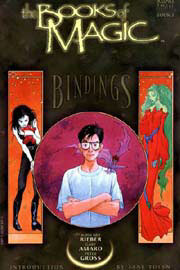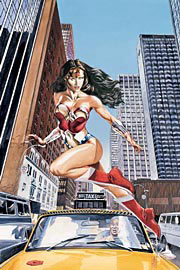This week’s regular column was so gargantuan, the trade paperback collections and original graphic novels were carved out and given their own space to breathe. For those of you out there who don’t/won’t/can’t follow regular monthly issues and/or prefer to page through a nice thick book, this is the place for you!

Earthboy Jacobus (Image Comics)
 Comic creator Doug TenNapel comes up with stories that aren’t particularly easy to describe, but they’re amazingly hard to resist. In his latest graphic novel Earthboy Jacobus, a young lad with strange markings on his hand is found by recently retired cop Chief Edwards (who, it should probably be mentioned, discovers him in the mouth of a dimension-jumping whale). He adopts the alterna-terrestrial boy as his own, but discovers that he’s being hunted by the Ectoids, a strange bug-like race that slides into parallel Earths and “saves” each world through assimilation, transforming it into their image. A former US Marine, Chief takes the boy into hiding and trains him in secret, preparing him for when the Ectoids eventually catch up – as Jacobus is the only being to resist conversion, they want to dissect him and ensure it never happens again.
Comic creator Doug TenNapel comes up with stories that aren’t particularly easy to describe, but they’re amazingly hard to resist. In his latest graphic novel Earthboy Jacobus, a young lad with strange markings on his hand is found by recently retired cop Chief Edwards (who, it should probably be mentioned, discovers him in the mouth of a dimension-jumping whale). He adopts the alterna-terrestrial boy as his own, but discovers that he’s being hunted by the Ectoids, a strange bug-like race that slides into parallel Earths and “saves” each world through assimilation, transforming it into their image. A former US Marine, Chief takes the boy into hiding and trains him in secret, preparing him for when the Ectoids eventually catch up – as Jacobus is the only being to resist conversion, they want to dissect him and ensure it never happens again.
Broken up into three chapters, the story looks at different periods in Jacobus’ life, jumping from his initial entry into our world to his rebellious teen years, and then later in early manhood as he wanders the Ectoid world searching for his lost adoptive dad. TenNapel’s art has a marvelous sense of energy, outrageously expressive characters and genuinely surreal concepts, and his occasionally poignant story never goes in the direction you might expect. It’s also exponentially more inventive than his last effort Tommysaurus Rex, which I found fairly pedestrian after his utterly brilliant Creature Tech (one of my favorite comic stories ever), and though it weighs in at a hefty 270 pages, I probably could’ve read twice as much.
FOUR AND A HALF OUT OF FIVE VIKINGS

Nil: A Land Beyond Belief (Slave Labor)
 Comics are at their finest when the story can best be told within the medium. Some comics just read like storyboards to a movie, while others bypass details that a novel could extrapolate on, but when the merging of visual and textual is at its peak no other format can portray the same information to the same effect. The storytelling method is unique in that it can exploit the subtlety of the written word and, at the same time, compliment or juxtapose those words with pictures, and vice-versa. Nil: A Land Beyond Belief by James Turner is just such a product, an original graphic novel that wouldn’t work nearly as well any other way.
Comics are at their finest when the story can best be told within the medium. Some comics just read like storyboards to a movie, while others bypass details that a novel could extrapolate on, but when the merging of visual and textual is at its peak no other format can portray the same information to the same effect. The storytelling method is unique in that it can exploit the subtlety of the written word and, at the same time, compliment or juxtapose those words with pictures, and vice-versa. Nil: A Land Beyond Belief by James Turner is just such a product, an original graphic novel that wouldn’t work nearly as well any other way.
Nil is an adventure story but only in part. Our protagonist is Proun Nul, one of the many citizens of the nihilist society of Nil who works for the un-government as a deconstructionist – an abolisher of ideals, religions, economic systems and philosophies. The irony is, of course, being that the whole structure of Nil is completely based on it’s own idolatry of death, anti-religion (complete with a Hypocripope and Uncardinals), governmental system (officials are selected in a Survivor-esque/Battle Royal-style death match), and the nihilistic perspective of life and the future. Nul is implicated in a murder, forcing him to run, sending him on a strange journey in which he unknowingly forms a freedom-fighting group (the “Bowel Movement”), and is enlisted in the war against Nil’s neighbor, Optima (naturally, a land of optimism).
Though Nul’s journey is the framework of the story, the bulk of the book is a satirical thesis on the ideology of nihilism and the dominance of a pessimistic and consumerist culture. Though dealing with a society of bleak individuals, Nil is an ingenious comedy at its heart, Monty Python-esque in both its intellect and execution. Heaven and Hell are treated as political realms rather than spiritual ones, while war, religion and government are all given the weight of being the shapers of society, and yet they are each run by complete idiots (the discourse between the Hypocripope and his Uncardinals about stopping reproduction and sparing unconceived children the certain misery of the future is brilliant in its absurdity).
The graphic novel is visually a work of splendor; illustrated in stark, colorless three-tone (black, white and grey) using computer-generated vector graphics, its design is like the product of Chris Ware interpreting “Samurai Jack”: simplistic in its complexity (or perhaps complex in its simplicity?). Pages are filled with amazing details and subtleties (propaganda posters proclaiming “Love is just a statement of ownership” and “Triplethink: Yes, No, Maybe” amongst others are scattered throughout, as are innocuous sound effects, and even more faint, grayed out background dialogue). Its steampunk technology and weaponry as well as the inventive spires of Fritz-Lang-esque architecture are a wonder to behold. The book is also enhanced by newspaper one-sheets of “The New Nihilopolis Times” (which proclaim stories of “Heaven Denies God Dead” and “Hell Invades New
Nil is by no means light reading. Long diatribes on the nihilistic position can be a bit of a slog to get through (but always worth the effort, if only for the punch line), and the visual subtleties can occasionally boggle the mind, but tiny complaints aside, the book is by far the most entertaining and inspired graphic novel since Kyle Baker’s The Cowboy Wally Show.
FIVE OUT OF FIVE VIKINGS

Books of Magic (DC/Vertigo)
 After reviewing the abysmal DC mini-series Day of Vengeance, which drops the reader in the middle of the DC Universe’s realms of magic, I figured it would be high time for me to pick up the quintessential volume of DC’s magic folklore, the Neil Gaiman-scribed Books of Magic. The trade paperback collects the 1990 four-volume mini-series that first introduced us to Tim Hunter (years before Harry Potter mind you) a young British lad with glasses who didn’t know his destiny to become the world’s greatest sorcerer. I knew the basic point of the book was that four characters dubbed the “Trenchcoat Brigade” were to lead Tim on a journey through the realms of magic. However, I didn’t realize that that’s all it is. There’s not really a story here, more like a sequentially told "Who’s Who" of the mystical players in DC Universe.
After reviewing the abysmal DC mini-series Day of Vengeance, which drops the reader in the middle of the DC Universe’s realms of magic, I figured it would be high time for me to pick up the quintessential volume of DC’s magic folklore, the Neil Gaiman-scribed Books of Magic. The trade paperback collects the 1990 four-volume mini-series that first introduced us to Tim Hunter (years before Harry Potter mind you) a young British lad with glasses who didn’t know his destiny to become the world’s greatest sorcerer. I knew the basic point of the book was that four characters dubbed the “Trenchcoat Brigade” were to lead Tim on a journey through the realms of magic. However, I didn’t realize that that’s all it is. There’s not really a story here, more like a sequentially told "Who’s Who" of the mystical players in DC Universe.
Gaiman presents idea after idea, but never capitalizes upon them. The different magicians and magic styles are just introduced but the potential of any them are never explored. He reintroduces us to characters from the realm of Limbo with mere sentences and teasingly leaves them at that. It’s a disappointment because this book is, in the strictest sense, all talk and no action. There’s no character development, just layers of ideas stacked one atop the other. There are a dozen more trade paperbacks featuring Timothy Hunter but I’m not inclined to read them, since this book didn’t give me enough of Tim Hunter’s character to care about.
On the geek side of me, I got a minor thrill playing "spot the b-grade hero", and the art – a volume each by John Bolton, Scott Hampton, Charles Vess and Paul Johnson – is gorgeous, mostly painted work. But there’s little substance to it, aside from being a tour-guide brochure.
TWO AND A HALF OUT OF FIVE VIKINGS

Wonder Woman: Down To Earth and Wonder Woman: Bitter Rivals (DC Comics)

 The trade paperbacks Down to Earth and Bitter Rivals begin a new era in the legend of Wonder Woman, and I think this is possibly the best representation of the character I’ve ever read. Wonder Woman isn’t exactly the most versatile character, but writer Greg Rucka has removed Diana from her superhero role and put her instead into the activist/icon role. Diana has set up shop in
The trade paperbacks Down to Earth and Bitter Rivals begin a new era in the legend of Wonder Woman, and I think this is possibly the best representation of the character I’ve ever read. Wonder Woman isn’t exactly the most versatile character, but writer Greg Rucka has removed Diana from her superhero role and put her instead into the activist/icon role. Diana has set up shop in
Thrusting Wonder Woman into the thick of political intrigue doesn’t give much room for her to flex her muscles, and so, while all this is going on, someone is letting loose all of Diana’s greatest adversaries, which invariably she must stop. Then, back in the land of the Greek Gods, some deadly manipulations are going on, leading to the displacement of
If you haven’t guessed yet, Wonder Woman has more in common with The West Wing lately than it does with The Incredibles. It’s brilliantly written, well paced, and saturated in so much intrigue you can’t stop reading.
FOUR AND A HALF OUT OF FIVE VIKINGS

Ultimate Galactus Book 1: Ultimate Nightmare (Marvel Comics)
 Ultimate Nightmare was the highly anticipated crossover mini-series between The Ultimates and the Ultimate X-Men, and, as far as crossovers go, it’s pretty weak (the teams barely get to duke it out). As far as first chapters of three-part series go, however, it works quite nicely. But we would expect nothing less from writer Warren Ellis.
Ultimate Nightmare was the highly anticipated crossover mini-series between The Ultimates and the Ultimate X-Men, and, as far as crossovers go, it’s pretty weak (the teams barely get to duke it out). As far as first chapters of three-part series go, however, it works quite nicely. But we would expect nothing less from writer Warren Ellis.
A broadcast has taken over every airwave on the planet, showing an alien race being mass slaughtered into extinction with the message that Earth is next. The broadcast, as much empathic as televised, leads thousands to suicide. Nick Fury and his crew triangulate the source of the broadcast, while Jean Grey and Professor Xavier sense a mutant telepath at work. Thus the two teams collide in a decommissioned Russian military base, where some sinister experiments had once gone on, but their legacy remains. The source of the transmission is a surprise Avengers fans will like; the message the source delivers is, however, a surprise ruined by naming the collection “Ultimate Galactus”.
Ultimate Nightmare plays out like a superhero version of the Outer Limits, not quite pure horror, but definitely scary, and not totally sci-fi, but certainly copping many elements thereof. The art by Trevor Hairsine and Steve Epting is similar to Brian Hitch’s work on The Ultimates, but cast in much darker shadows, effectively establishing the disturbing atmosphere the book is set in. I had wondered if Ultimate Nightmare was a necessary precursor to the current Ultimate Secret, but each book appears to be stand-alone while complimenting one another as a whole.
THREE AND A HALF OUT OF FIVE VIKINGS

DC: The New Frontier Volume 1 and 2 (DC Comics)
 Written and illustrated by Darwyn Cooke with colors by the master, Dave Stewart, it’s evident that The New Frontier, a four (oversized) issue mini-series collected in two volumes, was a labor of love. Recalling a bygone era of new, awe-inspiring science and technology held aloft by can-do attitudes, Cooke presents an alternate take on the dawn Silver Age of the DC Universe. Cooke never picks a clear protagonist, instead opting to use as many heroes of both glory and fading memory as he can. Clear favorites are obviously Hal Jordan, the Challengers of the Unknown, the Flash and Martian Manhunter, leaving the big guns – Batman, Superman and Wonder Woman – to their well-known iconic devices.
Written and illustrated by Darwyn Cooke with colors by the master, Dave Stewart, it’s evident that The New Frontier, a four (oversized) issue mini-series collected in two volumes, was a labor of love. Recalling a bygone era of new, awe-inspiring science and technology held aloft by can-do attitudes, Cooke presents an alternate take on the dawn Silver Age of the DC Universe. Cooke never picks a clear protagonist, instead opting to use as many heroes of both glory and fading memory as he can. Clear favorites are obviously Hal Jordan, the Challengers of the Unknown, the Flash and Martian Manhunter, leaving the big guns – Batman, Superman and Wonder Woman – to their well-known iconic devices.
Cooke tells the story of how heroes are created, not born, how spirit and drive can only be enhanced by super powers and well-honed abilities, not replaced. The two volumes are packed with origins, adventures and dawning moments of heroism, culminating in a heart-swelling moment of monolithic bravery and valor as dozens of the newly-powered and powerless alike battle a seemingly unbeatable foe. To the well-read DC fan, nostalgia radiates from the pages, but in such a manner as to add something completely new to the historical records.
Cooke’s artwork is magnificent, like a cross between Bruce Timm’s and Hayao Miyazaki’s styles of animation: classically bold and dynamic, but contemporary in execution. If I have any hesitation it’s that Cooke’s love letter may only be directed at or understood by DC Comics fans of old. I’m not sure how The New Frontier would read to a non-comics reader or even the new comic fan. But that’s so minor, from my perspective and in my context, it’s a work of beauty that should inspire the imagination and represent both how comics once were, and how they can still be.
FIVE OUT OF FIVE VIKINGS

To discuss this column and all things Nordic, you may contact Sean at scfahey@yahoo.com , Devon at thedevonsanders@yahoo.com , Dave at dave@chud.com , Russell at inadvertent@mail.com , Rob at poprob@gmail.com and Graig at graig@geekent.com.
HAVE A COMIC YOU WANT TO SUBMIT FOR REVIEW? Contact Sean at scfahey@yahoo.com.